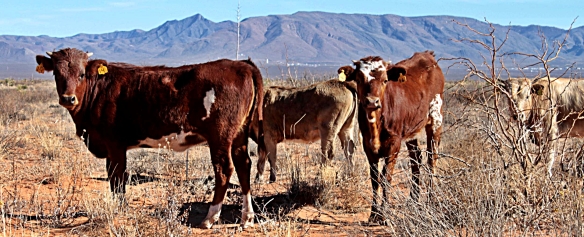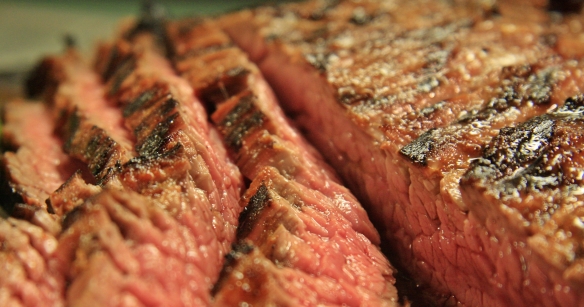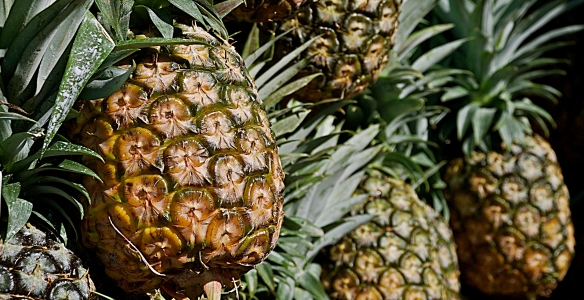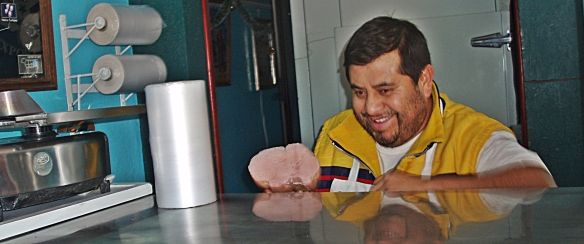If Mexican cows had jobs they’d be fashion models. Because if you’ve ever driven past a Mexican cattle farm you know that Mexican cows are often not much more than skin and bone.
Because Mexican cows are skinny cows they have little or no marbling (it’s those ribbons of fat that are the main influence on whether meat is tasty and tender). In addition, Mexican beef is rarely aged (the other big influence on whether it’s tasty and tender) So a lot of the meat you buy at a Mexican butcher shop can be almost as tough as the leather that some of the rest of the beast becomes.
Mexican beef is tough but definitely not tasteless. Mexican cattle are often still free pastured and seldom fed with supplemental corn. A diet of all grass and no grain gives the beef a taste that’s sometimes stronger (Don Day would use the word beefier if Don Day’s Wife wasn’t his editor and will probably remove it) and it’s often more interesting than U.S. or Canadian beef that’s finished on corn or barley or some other grain. So, for cheap cuts that are going to be slow braised in liquid, Don Day would always say save the money and don’t buy imported. Support your local butcher and definitely cook with Mexican beef.
Steaks that are going to be grilled, broiled or fried in fat, though, are a different kettle of fish…sorry I guess that should be kettle of meat. In Don Day’s opinion (and I’m always very opinionated when red meat is the topic of conversation) there are only six types of steaks cut from Mexican cows that you should ever consider purchasing: Blade, skirt, flank, hangar, tri-tip and filet mignon.
Forget about buying T-bones, porterhouses, strip loins or rib eyes in Mexican butcher stores. In San Miguel de Allende, shop somewhere like Mega where you can buy excellent imported beef (but only in that tiny area in the northwest corner of the meat department) or, if you don’t mind frozen, at Carnevino where, even though the meat originates in Mexico, the cattle are finished on corn in a feedlot, the same way it is in Canada and the U.S.
This post though is not about these more expensive (and mostly more tender) cuts of steak. This post is about six other very flavorful cuts, five of which are among the cheapest cuts of beef you’ll find anywhere.
First, let’s get one recommended steak, the one that’s not inexpensive, the one that’s very different from the rest, out of the way.
Filet mignon (tenderloin).
This one is very easy to find and easy to ask for in a San Miguel butcher shop if you don’t find it. It almost always goes by the name filete, or occasionally, bistec de filete. It’s different because it’s the only Mexican steak cut that can still be sufficiently tender without any marbling or without tenderizing. I find the Mexican filet just as good as the U.S. but it’s not necessarily any cheaper (especially if you don’t mind the drive to Celaya or Queretaro to visit that somewhat loved, sometimes hated, but always respected Costco).
The other five recommended cuts of Mexican beef all are better with tenderizing, either by pounding or with a marinade. Don’t consider any of my recommended Spanish terms for the cuts conclusive because, as one friend remarked, “he’s totally effluent en Espagnol”, and different references say very different things about the names. Plus there doesn’t seem to be any consensus among the butcher shops I’ve frequented in San Miguel.
Tri Tip.
Don Day had never heard of tri tip until he finally got California off his bucket list and actually moved there for a few years. When he left, he seldom saw it again outside of that state. Though many people consider this a roast rather than a steak, it can be just as good as a blade, flank, skirt or hangar steak, particularly if it’s marinated. And, because it’s usually cut thicker, it may be the best cut of all for treatment with a dry rub. I find it best to slice it before it’s served so guests aren’t awkwardly trying to cut it with the grain instead of against it and end up looking like grinning cows as they try to get their teeth through it.
Tri tip is one of the most difficult cuts to explain to a Mexican butcher and I’m guessing most butchers end up putting tri tip in the grinder. The most common Spanish term I’ve heard for tri tip is bistec de empuje but I’ve also heard punta en triangulo. Both terms, however, have also brought the head twisted to one side with one raised eyebrow look from Mexican butchers. The best plan may be to ask for la parte inferior del solomillo but it’s still going to be iffy whether you exactly get a tri tip. I also suggest using the word triangular (which is the same in English and Spanish) or even tri tip when you’re shopping; the butcher may have been through a similar exercise long before your attempt and may already know how to put a smile on a foreigner’s face.
Flank.
Don Day’s favorite of all cheap cuts comes from the belly, just in front of the rear legs. It was orginally popularized in Paris bistros under the name bavette. Today, under its Mexican name arrachera, it also has an international following.
Now I must tell you that a lot of people (including some Mexican chefs and Mexican butchers) think that skirt steak is used for arrachera but Don Day thinks the best arrachera is made from flank. You’ll find arrachera on menus in the southern U.S., in Venezuela and in Argentina. The word arrachera often isn’t used until the cut has been marinated. Before it’s tenderized, the butcher might know it as falda which can be extremely confusing as falda means skirt in Spanish and (remember this is Don Day’s opinion) arrachera is a flank steak not a skirt steak. Flank can also go by the name entraña except entraña won’t be as closely trimmed, leaving a layer of fat that can actually help in the tenderness when it’s cooked. And there’s one more word Don Day has seen for flank steak in Mexico (but never in San Miguel) and that is ranchera.
The French seldom marinate their flank steak and flash cook it medium rare. I’d recommend that Mexican flank always be marinated.
Skirt and Hangar.
These two cuts are both very difficult to find (or order) in Mexican carnicerias. After ten plus years of wintering (love using seasons as verbs) in San Miguel de Allende, I still find myself standing in front of butchers pointing to my oversized belly and blabbering in Spanglish, as I try to get the cut I want. The skirt and hangar are the two parts of a cow’s diaphragm that you’ll find in an area known as the plate. The skirt is at the top and the hangar hangs below it (hence the name).
Don Day even researched the internet again today going to every translation site I could find looking for the right terms for skirt and hanger. All I could find were falda and arrachera. The best Spanish word I can give you to use at the butchers is diafragma but you’re still going to need a lot of luck. One of the reasons they are difficult to find in San Miguel de Allende is that most skirt and hangar gets cut up in strips for fajitas before it ever leaves the butcher shop.
Blade steak (chuck steak). I hummed and I hawed about putting this cut in but ended up not being able to stop myself. It’s a cut that even the most sophisticated butchers in Canada and the U.S. may not be familiar with. If you’re like Don Day was until very recently and had only heard the word blade used with the word roast and had only considered it as one of the best cuts to make a pot roast, think again. The Healthy Butcher in Toronto rates this cut as the absolute number one value of all steaks when it comes to taste versus price. They suggest the cut can be grilled without any tenderizing but Don Day thinks it needs a little help from a marinade (or a lot of help from a braising liquid) in order to sing “Love Me Tender”.
The problem with walking into a San Miguel butcher shop is, no matter what Spanish words you use to order it, it’s very doubtful that the butcher will have even heard of it. Blade steaks are located in the shoulder, just above the front legs, an area often known as the chuck. It is cut from the bottom part of the chuck (the slightly tougher flatiron steak comes from the top). Bistec corazon de diezmillo is the name one San Miguel butcher uses for the cut and punta paleta is another name I’ve heard used for the cut but you’ll be lucky if either one works and it might be better instead to describe where a blade steak is located to a butcher. And maybe also cross your fingers. On both hands.
Try a little tenderizer
Don Day has to emphasize the importance of tenderizing blades, tri tips, flanks, skirts and hangars and the best way to do it is with a marinade. The problem with marinades though is they can overpower the taste of the meat if the wrong ingredients are used or if the steak is left too long in the marinade. The arracheras you purchase in the supermarket, vacuum packed in a marinade can be very good but they can also taste like teriyaki sauce, papaya or some other dominating ingredient rather than beef. My recommendation is to prepare the marinade yourself.
The single best marinade ingredient is pineapple. Pineapples are a member of the bromeliad family and bromeliads have an enzyme called bromelain. Don Day only took first year chemistry (when luscious Linda switched to botany so did Don Day) so I can’t explain it with atomic numbers but nothing breaks down collagen like bromelain and, best of all, it doesn’t overpower the beef taste. I pick up my pineapples at San Miguel’s Tuesday Market (at the same time as I’m looking for $3 Hawaiian shirts with pineapples on them). Never ever, repeat never ever, use canned pineapple or canned pineapple juice; I have no idea why but it just doesn’t work.
You can add a lot of herbs and spices in your marinade or just let the beef do the talking. The following are the basic ingredients I would use for four eight ounce blade, tri-tip, hangar, flank or skirt steaks.
1 cup of fresh pineapple juice
1/2 cup of honey
2 tablespoons of soy sauce
1 tablespoon of lemon juice
1/2 teaspoon of salt
Place the steaks and the ingredients in a plastic bag with a tight seal. Put on some old time rock and roll (rhythm and blues also works) and shake the bag around. Then refrigerate them for four hours. If it’s going to be longer before you eat the steaks, take them out of the marinade and rinse them off before putting them back in the fridge.
What butcher is going to give me the best chance of getting the steak I want?
Calle Colegio is butcher’s row in San Miguel with at least two carnicerias that will help you choose the best cuts of Mexican beef for steaks. Don Day thinks the very best San Miguel butcher though is La Nueva Aurora in Fraccionamiento La Luz. But it’s not exactly convenient for most people unless, like Don Day, you’re a regular at the Tuesday Market. From there, it’s only a couple of blocks away.
Alberto, Aurora’s master of meat, has lots of simple charts on the wall as well as a binder with virtually every cut of meat illustrated and described which, if you’re patient, he’ll go through with you, page by page. But that doesn’t suggest he’ll have the exact cut you want in the display cases. He might, however be able to walk into the fridge, bring out a side and then cut it while you’re there. If not, he’ll almost always be able to get it for you within a few days.
Carniceria La Neuva Aurora is located at Durazno #24 in Fraccionamiento La Luz, San Miguel de Allende, Mexico.









A very thoughtful and comprehensive article, but I’ve got some comments.
1. Many of your readers live here full-time. And while Mexican beef has its purpose, we crave imported beef to grill back the way we did in the Old Country. If you’re just making cocido or grilling it as skinny beef, Mexican beef is fine. But if you’re aiming for a fork-tender piece of aged beef, imported beef can be well worth the investment. There are some of us who remember the days when there was no imported beef to be had in this country. My favorite restaurant in Morelia, Parrilla y Canilla, serves beef imported from Alberta, and it’s nonpareil.
2. Filet is the least-exercised muscle in the beef animal, and even a cow filet is good, For some reason, it’s not terribly popular among Mexican customers and can be picked up in rural carniceras for practically a song. Well, for not much more than cheap cuts.
3. Arrachera does seem to run the gamut from skirt to flank, and the kind that’s sold already marinated is not infrequently meat that’s reached its sell-by date. Better to buy fresher meat and marinate it yourself, even if that means sprinkling on some suavizador.
Very interesting, Sr. Day – I like your restaurant reviews but as I am more of a home cook I find this type of information even more useful. I am not a beef lover – but it’s always nice to know what to look for when the urge strikes. Therefore it would be very helpful if you could indicate what kind of price range we should expect for these various cuts. I think / hope / expect my local butcher shop on Ancha deals as fairly with me as he does his other customers – but I would like to have some base point upon which to begin my treading. Thanks, as always – Lydia-jane
I was invited to a fiesta given by my neighbors this year. They killed a 3 year old cow, mostly grass free range for sure, but I think possibly eating corn foliage at this point in the year. I was surprised by how tender it was, and also how it lacked the strong wild taste that some free range has. This is the time of year when they eat beef…I wonder if it has to do with this finish.
I always bought 1 year old beef in Co for my freezer.